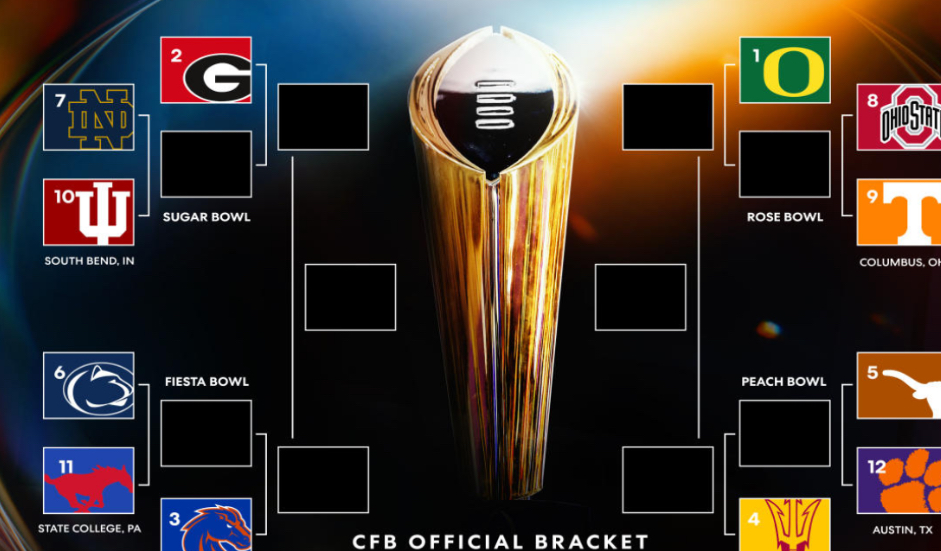The 12-team College Football Playoff in its first edition came with controversy and anger. As many fans watched “undeserving” teams such as Southern Methodist University (SMU) or Clemson University play, many quickly came to criticize the playoffs as a whole. Whether it is that these people want more teams or fewer teams or just plainly want to get more SEC conference teams in it, the 12-team playoffs is a broken system. There has been many different ideas people have thrown out, but I have a very plain, quick, and simple fix this broken system.
The College Football Playoff operated under a four-team system from 2014 to 2023. In this system, a committee consisting of school athletic directors would choose who they believe are the four best teams in the country. This system came under much criticism, and the playoff committee had no choice but to expand the bracket from four to 12 teams.
In 2024, with newly expanded conferences, the College Football Playoff committee decided now would be the best time for all to expand the playoffs to 12 teams. This would guarantee the four highest-ranked conference champions, the next seven highest-ranked teams, and the fifth highest-ranked conference a bid into the playoffs. The fifth highest is usually a team from the “group of five,” which historically has never been able to compete for a championship due to the lower skill level in these conferences.
In the College Football Playoffs, the four highest-ranked teams from the top four conferences get byes into the second round no matter the team ranking. Seeds five through eight host their round one game on their home campuses against seeds 9 through 12. However, the fifth seed could be the second-ranked team in the top 25 rankings but will be bumped down due to the conference champions getting the top four seeds due to byes. This was proven true this playoffs with Texas, the third-ranked team being the fifth seed. Or Arizona State, the 13th-ranked team being the fourth seed due to winning the Big 12. This means that the teams were seeded unfairly, giving Arizona State an auto-bye into the second round even though they were ranked lower than Texas, who had to play in the first round.
When teams were finally picked, all of the controversy the committee felt in the four-team playoff era immediately came back. Teams such as SMU with an 11-2 record or Indiana with an 11-1 record were quickly criticized for being chosen over teams such as Miami (FL) with a 10-2 record or Alabama and South Carolina from the SEC with a 9-3 record. As the teams chosen did not play as difficult of competition as the SEC teams. For example, Alabama played the 19th toughest schedule in the country compared to SMU, which played the 41st toughest schedule. ESPN Analyst Paul Finebaum said, “I just felt that SMU and Indiana were not particularly deserving.” Finebaum said. “I looked at four other schools: Alabama, South Carolina, Ole Miss, and Miami.”
When the games finally kicked off, the critics were quickly proved right. Seven-seeded Notre Dame, who was ranked (5) in the real rankings beat 10-seed Indiana (8), 27-17. Even though this game was a 10-point win for Notre Dame, it was the closest first-round game. 6th seeded Penn State ranked four crushed 11 seed SMU ranked (10), 38-10. Fifth-seed Texas beat the ACC champion, 12-seed Clemson, who was ranked (16) due to having a 10-3 record, 38-24. Then finally, 8th-seeded Ohio State (6) beat ninth-seeded Tennessee ranked (7), 42-17. After this round, people quickly came to criticize this format, stating it was “broken” and “unfixable” only after year one. When the second round came, the results became even more puzzling. As number (1) ranked and seeded, Oregon was destroyed in the Rose Bowl by Ohio State, 41-21. 2nd seed and ranked Georgia got beat by Notre Dame 23-10 in the Sugar Bowl. 3rd seed and (9) ranked Boise State got beat by Penn State 31-14 in the Fiesta Bowl. And in the closest game of the playoff, the fourth seed and (16) rank Arizona State lost 39-31 to Texas. This revealed that the higher-ranked teams that were seeded lower, for example, Penn State and Texas, were given easier opponents and were able to win. Oregon and Georgia on the other hand, were given much tougher opponents even though they were ranked (1) and (2) and lost. Putting all this information together, none of the teams who had a first round bye won their playoff game.
As anger grew with College Football fans, many people have thrown out many ideas for a new playoff system, but I have a simple and easy change.
I would still keep the teams at 12 and not expand it or decrease the size. The main major change I would make is plainly seeding the teams based on rankings. For example, Texas, who finished third in the rankings, would get the three seed and get an auto-bye. Arizona State, who was the fourth seed and got an auto-bye, would be the 11 seed as they were the second lowest-ranked team in the playoffs. Under this system, the true four best teams in the country can be awarded with auto-byes, and the five highest conference champions can be chosen.
If they were to expand the playoffs, let’s say, to 14 teams, then they would still have the same problem of the twelve and four-team playoffs of teams being felt they are left out. With twelve teams, it is the perfect amount of teams being able to compete. Under this new system, the same twelve teams would still be selected into the playoffs, but it would make the road to the championship easier or harder for teams. For example, Oregon, who finished 13-0 and was seed one, had to play Ohio State, who was the sixth-ranked team but eighth seed. In this new system, they would be able to play an easier team than the six-ranked team. Penn State, who was the sixth seed and fourth-ranked team, got to play SMU, the 10th-ranked team and 11 seed, and Boise State, the third seed and ninth-ranked team. The flawed system awarded worse teams rather than the better teams, and this simple fix of ranking teams 1-12 will fix that.
This simple fix will be easy to implement as soon as next year and will vastly improve the product of the college football playoffs. Also, by not expanding it won’t make it an outrageous amount of teams be able to compete for a championship, and not make it where not enough teams are able to compete for a championship.









